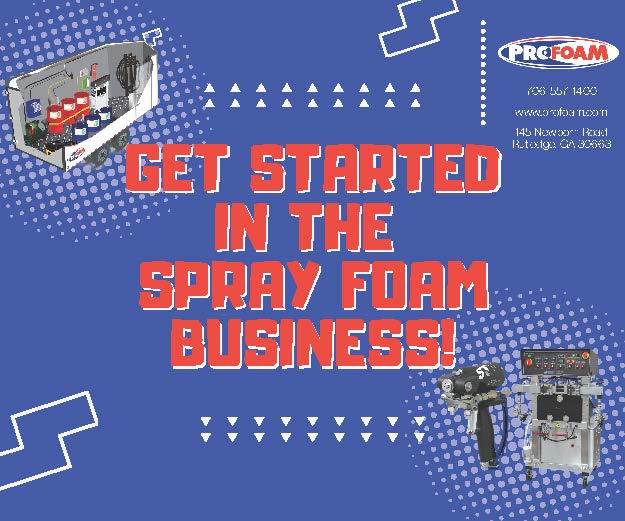
Spray Foam FAQ for Homeowners

Question:
Is spray polyurethane insulation code approved?
Answer:
Yes. Building codes provide for the use of spray polyurethane insulation in the Foam Plastic section. This section of the code also describes the use of thermal barriers.
Question:
At what point in the construction should spray polyurethane insulation be applied?
Answer:
Normally, spray polyurethane insulation is installed at the same point in the construction cycle as other types of insulation. That is, it should be installed after the rough plumbing, electrical wiring, and heating and air conditioning ducts have been installed. If you decide to seal the entire exterior shell with spray polyurethane, spray insulation may need to be applied in some areas before the ductwork is installed.
Question:
Are windows O.K. to have in a unvented attic that is insulated with spray foam at the walls and roof deck?
Answer:
Yes. Building codes provide for the use of spray
polyurethane insulation in the Foam Plastic section. This section of the code
also describes the use of thermal barriers.It seems like the radiation of heat through the windows
would make the attic hot. Windows in a conditioned attic are similar to windows
in your home. They are holes in the insulation. The energy they allow through
them will have to be made up from your heating or cooling system. Consider
removing them or covering them from the inside in some manner and insulating
them.
Question:
Answer:
Not practically. Spray polyurethane application requires complex equipment and a skilled installer with training in the safe and proper installation of the polyurethane system.
Question:
Answer:
Great question as we hear this a lot. Unfortunately for you DIYers, spray polyurethane foam (SPF) equipment is not for rent. Installation of SPF needs to be done by a well-trained installer. It's not as easy as it looks. There are some small kits on the market, but they are made for very small projects like sealing joints and cracks.
Question:
Answer:
Closed-cell SPF can be used under a wood roof deck where peel and stick is used as a moisture barrier above the deck. Proper design is critical especially in very cold climates where the vapor drive is outward for a significant amount of time. A ventilation chute between the foam and the wood deck that is connected from the soffits to the ridge vents is an option for some designs to ensure moisture if properly vented.
.
Question:
I have a house built on a slab in a flood plain. From time
to time, I get water in the house. To remediate after a flood, I must open up
the walls about 24 inches and dry out the walls, and then replace the
insulation and the sheet rock. If I could use an insulation which would not
hold water and install wonder board on the first two feet of the walls it would
be a big improvement. Can closed-cell foam be used in this application?
Answer:
Closed-cell spray polyurethane foam (SPF) is an excellent
option for you. Closed-cell SPF is listed as a Class 5 Flood Damage-Resistant
Material per FEMA. This means it is "Highly resistant to floodwater
damage, including damage caused by moving water. These materials can survive
wetting and drying and may be successfully cleaned after a flood to render them
free of most harmful pollutants." It is the only insulation material that
meets this classification. You can read all about it in the FEMA Technical Bulletin 2. It would be an
excellent idea to install closed-cell SPF into your walls the next time you
have to open them up.
Question:
I'm planning to use an open-cell spray foam in the 2X6 joist
between my basement and first level. Can I top it off with that Roxul Safe and
Sound Insulation?
Answer:
There are no chemical compatibility issues between open-cell
spray polyurethane foam and rock wool insulation. You need to make sure,
however, that the combination is designed properly for your climate zone and
building code.
Question:
I am building my own home, and want to spray insulate
myself, as I have my house and several outbuildings that I want to insulate. I
am planning to buy a Graco system out of the States, and have the seller do the
training. I understand that I need CCMC approved foam for Canada. Do I need
some further certification in order to purchase foam here in Canada? Will the
training certificate provided by the seller of the system be adequate? An installer
does not have to be certified by the Canadian Spray foam insulators association
in order to spray, correct? What certification do you need in order to spray
yourself? Some people import foam from the US, but that is not allowed, or just
not up to Canadian code?
Answer:
I’m not an expert in the Canadian market, but here’s what I got from some of my sources. The National Building Code of Canada (NBC) only references CCMC-approved foam so you need CCMC approved foam to legally use it in a building. You need to purchase foam from a manufacturer who has a CCMC approved foam in Canada. They will lead you through the process of getting certified to install their foam. All buildings that fall under the NBC need to have products that are CCMC approved. Try going to the CNRC website to look up spray foam products that are approved then contact those manufacturers. This may also be a great question for the SprayFoam.com forum.
Question:
Is cured spray foam insulation toxic? We recently removed a
large quantity of it and are at a loss as to how to dispose of it. It has great
water retention and I was wondering if it could be broken up into small pieces
and mixed into garden soil. What harmful effects are known?
Answer:
Spray polyurethane foam is approved for use as an insulation
material in contact with soil, but we do not know how foam scraps would perform
as soil fill, therefore, cannot recommend its use for this purpose. The
standard means of disposal of spray foam scraps is to dispose in normal
construction waste to a landfill.
Question:
I would like to insulate the ceiling of a crawlspace with
closed cell spray foam insulation. Sometimes the crawlspace floods but only
with a few inches of water with a little less than two feet of space between
the insulation and the water. However, with Sandy our crawlspace had over two
feet of water and the fiberglass insulation got wet and I needed to replace it.
Can I use spray foam?
Answer:
You can use closed-cell spray polyurethane foam (SPF) for your crawlspace in flood prone areas. FEMA has classified closed-cell SPF as a Class 5 Flood Damage-Resistant material. This is the most stringent classification from FEMA’s Flood Damage-Resistant Materials Technical Bulletin 2. Search for FEMA TB2 on the internet and you should be able to find a publication that explains this further. The latest Technical Bulletin was published in August 2008. This would also be a good option for the lower sections of walls and ceilings that may be affected in a flood event.
Question:
If I install a wood stove in a foam insulated home, will it
rob all the oxygen out of the air, or what steps do I need to take to insure my
fire gets the proper air it needs? Also, does my attic need to be vented like
if I install spray foam? Or does it need to be sealed where no air can enter?
Answer:
Realizing the need to consider proper ventilation is a very important first step when you install spray polyurethane foam in your house. Now that you're installing a wood stove, it is even more critical. Not being a ventilation expert, I would recommend first contacting the stove manufacturer to determine how to provide proper ventilation. They may be able to help to ensure it works properly and doesn't cause any issues. I'd like to point you to this document and advise you consult with a ventilation expert that I can recommend. See section 6.4 in this document.
I don't quite
understand your second question. The choice to provide a conditioned or vented
attic typically depends on if you have HVAC equipment or ducts in your attic.
If you attic is void of air ducts or HVAC equipment, the most energy efficient
option would be to provide a good air seal on your attic floor, seal up any
penetrations and create a vented attic. You would put the insulation on the
attic floor. If there are HVAC ducts in your attic, creating a conditioned
attic where the insulation is under the roof deck is a good option. This puts
the HVAC equipment inside the thermal envelop.
Question:
How does spray foam work?
Answer:
A two-part mixture is applied by trained professionals to the surface to be insulated. The spray mixture expands rapidly to fill all cracks and voids, completely and permanently adhering to wood, masonry, metal, concrete, and most other construction materials.
Question:
I have purchased a double wide in Godley Texas, and would
like to know if this is a good product to spray on the underside of the double
wide? Will it insulate the home better and pipes, or should this not be used?
Answer:
Insulating the underside of a trailer with spray polyurethane foam is much like insulating the underside of a home in the crawlspace. It is a good idea and should help with the energy bills especially if there is no insulation there presently. Work with the foam manufacturer or contractor to select the right product for your climate. Make sure you follow all applicable building codes.
Question:
I live on a busy street and wanted to know which insulation
(open-cell or closed-cell foam) would be best to install on the
"road-side" wall of the home to help reduce noise from the outside
traffic?
Answer:
To help reduce outside noise through a wall, either open or closed-cell spray polyurethane foam is a good choice. The most important choice is to use the correct type for your climate zone.
Question:
What is the proper way to insulate a residential attic space. Is the foam applied to the underside of the roof rafters or is it applied between the attics floor joists. I have been told the it gets applied between the roof rafters?
Answer:
This all depends on what benefits you are looking for. Either way will work perfectly but sometimes there are advantages for one over the other.
I would insulate the floor unless:
1. My HVAC equipment and ducts are installed in the attic. Insulating the roof deck brings these energy losses into the thermal boundary saving the lost energy.
2. The attic space may be finished at a later date.
3. I live in a hurricane zone and I have an older home where I want to increase the wind uplift resistance of the roof deck.
Question:
If we have our new home insulated with the spray foam do we need a special hood vent for our cook top?
Answer:
Excellent question. I believe your question has less to do directly with installing spray foam, but more to do with creating a house that is very air tight. However, it's good you've recognized that spray foam helps you create an air tight home. For range hoods in a very air tight home, you basically want to uncouple the hood from the rest of the house by providing its own dedicated makeup air system. Check out this article from the fantastic people at Building Science Corp that can air it all out for you.
Question:
I had my attic rafters spray foamed in 2010. Recently, a specialist did an energy inspection and made the observation that the batt insulation in the ceiling had not been removed and in many places the foam came down to the batt insulation but not to the plate at the top of the perimeter walls. He now recommends that ALL the batt insulation be removed and openings be re-foamed to create a complete seal. Is he correct that all the batt insulation should be removed?
Answer:
Answering your question fully requires more information. It’s not clear whether the insulation installed on the roof deck is intended to be the thermal boundary of the house or was installed to reduce the solar gain acting much like a radiant barrier. A radiant barrier reduces the temperature gain in the attic taking the load off of the insulation on the attic floor. In this case, the attic is still vented and the attic floor insulation will remain. If the intent of installing SPF to the roof deck was to create a conditioned attic (non-vented) then the recommendation would be to first remove any insulation and vapor retarder from the attic floor then to install SPF on the roof deck and gable walls. The SPF should also seal off any vents from the exterior to the attic space creating a complete seal and thermal boundary that ties into the insulation boundary in the walls. Removal of the attic floor insulation allows the attic to come to equilibrium with the living space. Also, when the thermal boundary is at the roof deck, the fiberglass insulation which could also contain dust, contaminants, pest remains, etc, are now essentially part of the interior of the house. Various contaminants or odors collected over the years that were once vented to the exterior in the attic are now part of the interior of the house. It is recommended to remove the attic floor insulation when creating a conditioned attic for these main reasons.
Question:
I am trying to insulate a house roof. I have beam construction with two, in tongue and groove decking. Metal roof on the decking. I want to remove the metal, build a 2x4 or 2x6 frame on the deck, blow the space with closed-cell foam, put OSB decking, and replace the metal. I need suggestions. Should I spray straight on wood? Does the cavity need to be vented? Peel and stick on top of OSB, under metal?
Answer:
Installing closed-cell spray polyurethane foam on the top side of the ceiling finish is acceptable. You want to make sure the tongue and groove decking is tight and will not allow the liquid chemicals to pass through any cracks while it is curing. I think it would be good practice to ventilate the air space between the foam and the OSB roof deck. You would also want to drill weep holes into the eaves near to top of the foam layer to drain any water that may pass through the primary roof as a roof leak.
Question:
Does the expanding foam have serious hydraulic qualities?? If sprayed behind studs will it move, warp or lift building material?
Answer:
It is not recommended to spray or pour spray polyurethane foam in a wall cavity because the expanding force may cause damage to the interior or exterior sheathing. The best solution is to install the foam when either the interior or exterior sheathing is removed during a remodel.
Question:
I am looking at having spray foam insulation installed in an attic space that we will be converting into a large walk-in closet. My concern is what effect will the foam have on my asphalt shingles? I've been told it will be no problem and I've been told it will shorten the life of my shingles due to the extra heat.
I'm assuming that you are installing the spray polyurethane foam to the underside of the roof deck. The concern here is with an unvented attic where insulation is installed directly under the roof deck, the shingles may degrade rapidly due to the increased heat caused by the insulation.
Answer:
This concern is over exaggerated. There are a couple excellent papers and presentations written by Building Science Corporation (www.buildingscience.com) that cover their research regarding shingle life in unvented attics. They conclude that in Las Vegas, one of the hottest locations in the US, the average roof deck temperature difference between a unvented attic and a vented attic is 17 F. This is from research that they conducted on actual homes. This difference would only be less in the rest of the country. They have also determined that asphalt shingles installed over VENTED roof decks in hot-dry climates are generally warmer than the same shingles installed over UNVENTED shingles in a hot-humid climate like Orlando.
Finally, the difference in color from white and to black creates a larger temperature difference than unvented versus vented roof decks. The argument for these points is that shingle manufacturers do not have separate warranties for different climate zones or different shingle colors. The small increase in shingle temperature due to vented versus unvented is insignificant compared to other factors.
Question:
I live in Massachusetts & had an energy audit. My home has a crawl space with dirt floor with a 4 ft. high concrete block foundation. The vents are sealed. There is no furnace, no appliance or combustion device installed in the crawl space and there is no access to the crawl space from inside the house. The auditor's recommendations are: 1) Install a 12-mil vapor barrier on the crawl space floor & run it up the exterior walls to 2 inches from the top edge. 2) Spray three inches of closed -ell foam on the entire perimeter wall of the crawl space and also the rim joist. Will the foam adhere well enough to the flexible 12-mil vapor barrier to remain intact for years, or should the vapor barrier run up the wall only about 8 to 10 inches, the thought being that the foam will more strongly adhere to the foundation block?
Answer:
I've seen or heard of this done either way. Spray polyurethane foam can stick to membranes, depending on which ones they are. I'd work with the contractor installing the products. Make sure they can guarantee that the foam will stick to the membrane or make sure the foam is applied to the block.
Question:
Do I need to take any precautions when finishing an un-vented attic space with a spray foamed ceiling/roof? Do I need a plastic barrier or anything before applying sheet-rock to the attic joists? The space will be air conditioned and has windows, but is otherwise un-vented.
Answer:
To help reduce outside noise through a wall, either open or closed-cell spray polyurethane foam is a good choice. The most important choice is to use the correct type for your climate zone.
Question:
I am considering using the product under the house in crawl space (subflooring) as there is no insulation (old structure. What considerations are there as to existing termite bond, future termite infestation (termite resistant properties?). I understand the material is not cellulose based but is it termite resistant?
Answer:
If you are installing spray polyurethane foam (SPF) up against the underside of the floor in the crawlspace, then your termite inspector can continue to inspect for termites around the perimeter. If you are installing SPF on the walls of the crawlspace, then you need to leave an inspection strip around 6" wide on the walls.
Question:
If we foam spray our garage open rafters do we need to put dry wall underneath?
Answer:
Spray foam must be protected by a thermal barrier such as 1/2" gypsum wallboard. In a garage, this rule would apply.
Question:
I have recently had close cell insulation sprayed in a metal building The contractor was suppose to install 2" of foam and states they sprayed 5 coats of insulation However the actual thickness is 1"-1-1/8" He is claiming the foam did not expand as it should have but that the material for a 2" of foam has been sprayed. I don't know what to believe .
Answer:
Based on the information you have provided, this does not make sense. For one, 2" of closed cell spray polyurethane foam (SPF) would typically be applied in one or two passes or "coats" as you say. It makes me wonder what the contractor was installing if they said 5 coats? A coat typically applies to paints or coatings, not SPF. Also, if you were specified 2" and only received 1.125", then something is wrong. Claiming that the foam did not expand as it should is not your fault but either the contractor's or the chemical supplier's. Nothing about what you have said makes sense to me. Either there is some misunderstanding or you have not received what asked for. I would ask for a better explanation from the contractor.
Question:
What is the warranty on the spray foam insulation?
Answer:
You will need to contact the foam manufacture directly for information on any warranties. There are many manufacturers referenced on www.sprayfoam.com that you can contact for information.
Question:
When can spray foam be installed?
Answer:
Spray foam insulation is professionally installed at the same point in the construction cycle as other types of insulation. That is, using traditional building techniques, spray foam should be installed after the rough plumbing, electrical wiring, and heating and air conditioning ducts have been installed, but before the interior walls are completed in new construction. In some cases spray foam also can be applied in older buildings or structures, to the inside of roofs and under floors after construction has been completed.
Question:
Will re-roofing damage foam under the roof
Answer:
This is a great question. Both open-cell and closed-cell spray foam insulation adhears extremely well to the underside of roof decks and the rafters surrounding them when installed correctly. I have not heard of any evidence to support your theory. This should not be a concern when applying foam to the underside of a roof deck.
Question:
Won't sealing my building with spray polyurethane foam lead to indoor air quality problems?
Answer:
Your building does need to be ventilated in order to
maximize indoor air quality (moisture levels and contaminant levels). Most
design professionals will advise you to seal the structure as tight as possible
and provide the necessary ventilation through the heating and air conditioning
system. Many systems employ a highly energy efficient "air exchanger"
which is designed to pre-condition (either warm or cool) the incoming outside
air with the outgoing exhaust air. In this manner, you can build an extremely
energy efficient exterior shell using high-performance spray foam
insulation while still providing controlled and energy efficient ventilation.






